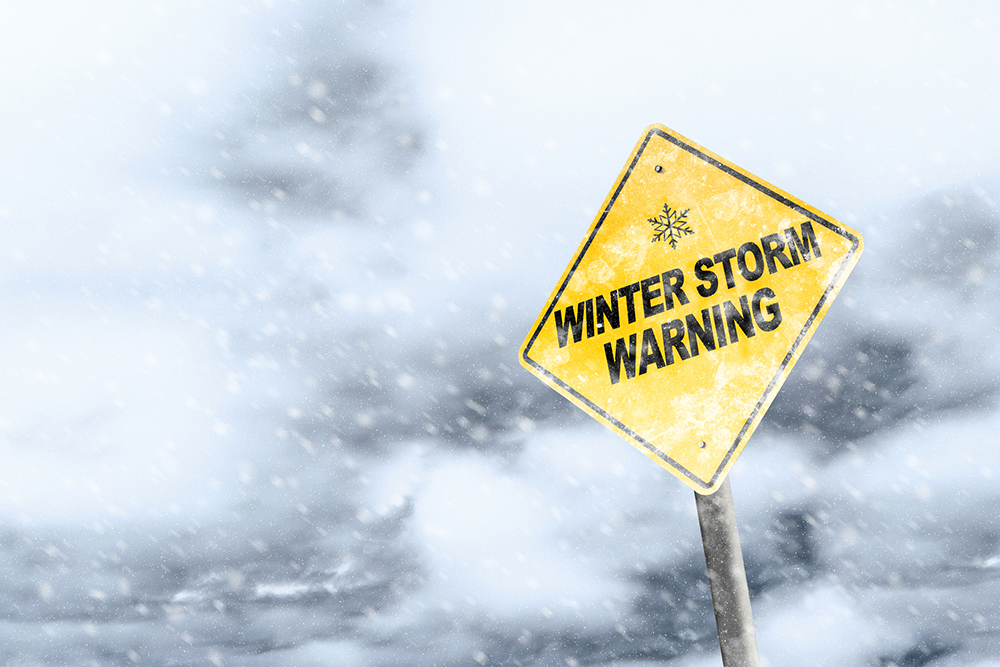
By Mike DuBose with Blake DuBose
Unexpected severe weather can wreak havoc on homes, businesses, cars, and lives. We saw this firsthand in 2014, when arctic blasts struck South Carolina’s Midlands with freezing temperatures, ice, sleet, strong winds, and snow. More than 30,000 homes were without power for five or more days, and many went waterless when their pipes burst from the extreme cold. “Never before have we seen so many homeowners unprepared for the cold temperatures,” said Kevin Meetze of Meetze Plumbing. “Our crews worked round the clock for weeks to help people get their busted pipes repaired and water restored!” Again this year, weather forecasters anticipate that temperatures in the next few months will fluctuate from the low teens one day to spring-like weather the next.
Over the last few years, we have been updating our homes and businesses to lower electric bills, decrease the chances of power outages, and prevent disasters, both in summer and winter. To further our research, we conducted interviews with the following exceptional vendors who service our companies and homes: Sam Cassell of Cassell Brothers Heating and Air, Chip Huggins of Duraclean, Kevin Meetze of Meetze Plumbing, and Scott Moseley of Irmo Insurance Company.
Based on these interviews and our experiences, here are some simple tips to avoid weather-related headaches this season:
- Know what’s coming. Check the Weather Channel’s ten-day forecasts regularly (they have an excellent smartphone app for on-the-go reference). When you see temperatures projected to dip into the twenties or teens, it’s time to act!
- Establish relationships with plumbing, heating/air conditioning, auto repair, and power back-up businesses before you need them. If major problems or widespread outages occur, these companies will turn their attention to loyal customers first. (For help selecting vendors to protect your home and other property, see the Quality Vendors Guide under “Recommended Readings” here.)
- Conduct an energy survey. Upon request, SCE&G and other utility companies will implement an excellent energy survey of your home for free.
- Obtain a backup cooking method. Buy a grill with two tanks of propane gas, and always keep a backup tank on hand. If you lose power, you’ll have an electricity-free way to prepare food!
- Consider purchasing natural gas-powered devices. Gas fireplace logs, for example, not only look nice but can help heat a room if the power goes off. If you have natural gas in your neighborhood, SCE&G will run gas lines to your home at no charge. They will also provide financial incentives if you purchase natural gas water heaters, fireplace logs, heating units, etc. Visit sceg.com for details if you are a customer. If not, you can rent large propane gas tanks from companies that sell gas devices. (When buying items, please note that there is a difference between propane and natural gas!)
- Install natural gas-powered equipment safely. Use quality vendors like Meetze Plumbing and Cassell Brothers when installing a gas device because it is a complex operation that is heavily regulated. In addition, if you plan to install any type of gas device near or inside of your home, procure several combination carbon dioxide, smoke, and fire detectors to ensure safety. (Consumer Reports recommends First Alert, which can be found at Lowe’s and other home improvement stores, as its first choice.) In gas equipment, the heat exchanger may crack, releasing poisonous carbon monoxide inside your structure. This is one of the most common problems with gas equipment, according to Sam Cassell, who said, “Ninety percent of the gas equipment we repair is because of cracked heat exchangers.”
- If your home has a crawlspace, close the foundation vents during the winter months. This will help the area underneath your home stay above the freezing point, reducing the chance of frozen pipes. When spring arrives, open all of the vents to allow the crawlspace to breathe. If the vents are difficult to close, you can insert cardboard or newspaper on the exterior to close them off, keeping heat in and cold air out.
- Cover or wrap all spigots during winter and disconnect all hoses. Inexpensive covers can be found at Lowe’s and are very easy to install, or you can wrap old towels around spigots and secure them with duct tape. Meetze Plumbing installed freeze-proof spigots for us, which are another option.
- When temperatures drop into the twenties or below, leave water running at all indoor fixtures (hot and cold) that are adjacent to an outside wall. Don’t just drip—the stream should be roughly the size of a pencil, according to Kevin Meetze.
- Prevent areas like wells and garages from freezing. If you have a well, run an extension cord with a mechanic’s light (sold by most auto parts stores) to keep the inside of the pump cover warm. In the garage, use a space heater to keep the area slightly warmer than 32 degrees Fahrenheit so that pipes in the garage wall or ceiling don’t freeze.
- Keep all rooms located on the exterior of the house at 60 degrees Fahrenheit or above. When temperatures drop, the outer walls of these rooms get very cold, and pipes within them can burst. We used to turn off the heat vents to these rooms to save on electric bills, but we now know that those savings would be negated if a pipe burst!
- If you have a tankless water heater, insulate the plumbing leading into and out of the unit. According to Meetze and other experts, tankless heaters are protected inside the box, but the plumbing going in and out of the unit isn’t. You want to run a little less than half of a gallon of water per minute from your interior faucets on very cold nights so that the unit does not fire up but water is flowing through pipes to avoid freezing. (If you do not have a tankless water heater yet but plan on getting one, choose one of the densely insulated types that can be located outside the home—we recommend Noritz brand. Those located in the attic can potentially flood your home.)
- Locate the shutoff valve for your house’s water supply. It can usually be found inside the water meter box close to the street. You will also need to obtain a tool (like locking pliers) that can turn the valve to an off position. That way, if the pipes freeze, you will be ready to turn off the water and avoid flooding!If a well is your water source, learn which electrical breaker controls the well’s pump.
- Insulate water pipes to prevent them from bursting. Home improvement stores sell round foam tubes with a split in the middle that you can simply snap over the pipes located in your crawlspace, attic, and other parts of your home. Check the size of the exposed water pipes under your home before going to the store to buy the insulation since they come in different sizes.
- If you’re worried about pipes freezing overnight, follow Meetze’s advice: “The best method for peace of mind is to turn off the water to the entire home when going to sleep and then open all faucets (hot and cold). Next, turn off the breaker to your water heater (tank type heaters) so the elements inside the heater are not exposed without water, and sleep tight! In the morning, just turn the water main switch on, and wait ten minutes to flip the hot water heater breaker back on (it takes about an hour to restore hot water). Then, close the faucets after they quit sputtering from the excess air in the pipe lines. Of course, you will be temporarily without water, but only for a night, which is way more convenient than replacing floors, ceilings, and other valuable belongings.”
- If you discover that your water pipes are frozen, call a plumber. Don’t wait for them to thaw.
- Bring pets indoors when temperatures drop. If your pet absolutely cannot come inside, buy a dog or cat house of the appropriate size and equip it with a heating pad (covered by a towel) set on low. Throw some covers over the house to trap warmth inside and leave a crack for the pet to breathe.
- Cut away tree limbs near the home. If branches get weighed down with ice or sleet during storms, they could snap and cause damage. Pine trees are especially dangerous near homes since they have shallow roots and are prone to fall during snow and ice storms or high winds.
- 1Maintain emergency supplies. When storms approach, you want to be ready with items such as a battery-powered radio, extra batteries, bottled water, firewood (if you have a wood-burning rather than gas fireplace), non-perishable foods (cereals, dried fruit, canned meats, chocolate, etc.), flashlights, candles, matches, and extra blankets. Always buy food in advance before the mad rush to the grocery stores! We keep small, powerful flashlights throughout the house and in each of our cars so that we always have a source of light at hand. Also, if temperatures drop below freezing and you are concerned about losing access to water, fill your bathtubs and you will have water to flush the toilets or wash off.
- Clean your roof gutters regularly. They can clog, freeze, and cause damage if the temperature gets low enough.
- Keep food safe during outages. When power goes out, avoid opening your refrigerator or freezer except for quick periods. You don’t want the cold air to escape, leading to food spoilage! If the power is off for extended periods, you can transfer frozen items from your freezer (in plastic baggies) to your refrigerator to help keep it cool. Or, consider letting Mother Nature do the job when outside temperatures are in the 30-40s by boxing up your food and setting it outside.
- To retain heat, keep garage doors closed. Insulating your garage will also help.
- Avoid damage from power surges. During power outages, unplug your expensive equipment and appliances. Also, all important appliances should be plugged into a good surge protector, like our preference, Isobar brand (found on Amazon.com). You may want to consider heavy-duty backup batteries (sold at Best Buy) for computers that can also be used to power up cell phones during extended outages, but beware of the beeping sounds they will make when the power goes off!
- Have your heating and air conditioning equipment inspected twice a year. Sam Cassell noted that it’s important to keep your heating well-maintained so that problems can be identified and addressed early on. He also said that heating coils must be kept clean, to not only increase efficiency, but also to reduce the chance of the units freezing in winter. Most companies, including Cassell Brothers, offer maintenance agreements. When units go out, clients with these agreements are first on the list to be served! Maintenance agreements also yield discounts on service and parts.
- During storms, remove any snow or ice from the top of your heating and air equipment. Ice buildup can lead to unit failure.
- Install a home generator. There are many options available to consumers. A small gasoline-powered generator can keep lights and some appliances operating using long extension cords. For best results, consider a whole house generator that can power all your home appliances and equipment. Installing a whole house generator is a very complex process that must follow strict regulations and involves several people (power generator experts, electricians, natural gas specialists, the power company, and county license regulators), so you want to use a reputable vendor like Cassell Brothers if you decide to get one. (You may contact Sam Cassell for an excellent article about all the details of buying and installing a whole house generator.) We recommend Generac brand generators.
- If the roads are icy, stay home. Too many people are injured, stranded, or killed venturing out into bad road conditions each year. You may be fine driving on the ice, but consider all of the inexperienced people who will also be on the road!
- Secure your vehicle. When snow or ice is in the forecast, park your car in a level area with road access and cover your windshield with plastic or newspaper. If you have a garage on a level surface, store your car there. Fill the gas tank before any storms hit—when the power goes out, so do gas stations. Also, ensure that your antifreeze is up to par to avoid an engine block cracking from freezing temperatures. Generally, if the coolant is a bright and clean green, you should be fine. You can check by taking off the radiator cap and inspecting the fluid. (For best results, have a trusted mechanic examine the coolant before temperatures reach emergency conditions.) Beware of antifreeze leaks—pets naturally want to consume the sweet fluids, which can kill them.
- If you are a business owner, develop and communicate an emergency plan to contact your employees when adverse weather hits. Many staff members may be able to work from home. In determining when to close our companies, we generally follow the state government’s precedent.
- Prepare your home before leaving for extended periods. Leave a key for someone to check in so if there are any problems (burst pipes, etc.), they will see it sooner and you can act to prevent further damage. When we go on long vacations, we often turn off the water and water heater just in case.
- When necessary, contact an emergency cleaning company ASAP. If you experience flooding from broken water pipes, a fire, or other disastrous event, contact a reputable cleaning and restoration company like Duraclean immediately. Speed is essential, as others are probably experiencing the same issues and it’s generally “first come, first served.” According to Duraclean’s Chip Huggins, “All the disaster companies in the Midlands were not prepared for so many emergencies that occurred in 2014. It took us months to catch up from so many requests!”
- Remember: a little planning goes a long way. All of these preparations may take time, but it’s nothing compared to the mess you could be left with if you aren’t careful. As Huggins noted in reference to 2014, “Many of the disasters we cleaned up were preventable.”
The bottom line: At some point, we will all be faced with weather conditions that can disrupt or even make our lives miserable! However, with a little advanced effort, you can ensure that you and your family are quite comfortable during extreme weather. Follow the motto that our companies and family do: “Hope for the best and plan for the worst!”
About the Authors: Our corporate and personal purpose is to “create opportunities to improve lives” by sharing our knowledge, experience, success, research, and mistakes.
Blake DuBose graduated from Newberry College’s Schools of Business and Psychology and is president of DuBose Web Group. View our published articles at www.duboseweb.com.
Mike DuBose, a USC graduate, has been in business since 1981 and authored The Art of Building a Great Business. He is the owner of four debt-free corporations, including Columbia Conference Center, Research Associates, and The Evaluation Group. Visit his nonprofit website www.mikedubose.com for a free copy of his book and other useful articles.
Katie Beck serves as Director of Communications for the DuBose family of companies. She graduated from the USC School of Journalism and Honors College.



